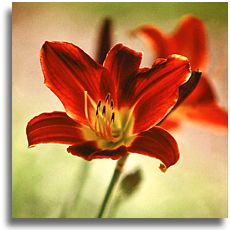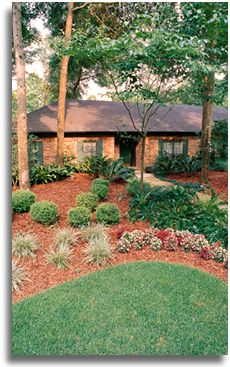

Xeriscape Home | Xeriscape Principles | Xeriscape Plant List | More Information
Why Xeriscape?
 Why
does the St. Johns River Water Management District care what plants you
choose for your yard?
Why
does the St. Johns River Water Management District care what plants you
choose for your yard?
Water managers care because many landscapes require a lot of water to flourish. Nearly 50 percent of all water used daily in a typical Florida home goes outdoors, with much of this water, for lawn and garden irrigation.
Florida, now the fourth most populous state in the nation, is growing by more than 600 new residents each day. To meet the challenge of increasing demand on our freshwater supplies, each of us must take responsibility for protecting our water resources by using water wisely.
With the goal of wise water use in mind, the District offers you this Xeriscape plant list. Xeriscape is landscaping that conserves water while protecting the environment. By applying the seven Xeriscape principles, anyone can establish a lush, low-maintenance landscape while minimizing water use.
Xeriscape landscaping doesn't need a lot of irrigation or attention. Such landscaping practices will reduce your water bill, reduce yard work and will make your new or current landscape attractive and healthy, even during a drought. Xeriscape landscaping also helps protect the environment by reducing the use of fertilizers, herbicides and pesticides.
The central mission of the regional water management districts is to manage water in the public interest to provide for its conservation, restoration and proper use. We hope that with the help of this guide, you will make your home or business landscape more attractive and water-efficient while assisting the District in protecting Florida's precious water resources.
Benefits of Xeriscape
Following Xeriscape guidelines helps promote healthier lawns with deeper roots which are not subject to fungus and other diseases.
Xeriscape landscaping protects the environment by using native plants that have adapted to local conditions, are drought-tolerant and have developed a resistance to many insects and diseases.
How much water is enough?
A rigid irrigation schedule is not necessary, especially when Mother Nature helps water your landscape with rain.
In general, most Florida grasses need only about one-half of an inch of water each time it rains or you irrigate. Watering needs change throughout the year.
 Here
are water needs for grass when rain is not available:
Here
are water needs for grass when rain is not available:
-
Between April and August, irrigate about every three to five days.
-
In September and October, water every five to seven days.
-
During winter months, water only once every 10 to14 days.
When can I water my lawn?
Outdoor irrigation is allowed only before 10 a.m. and after 4 p.m. daily, unless reclaimed water is used and a sign stating its use is displayed. The watering hours rule is in effect year-round.
The rule applies regardless of whether the water comes from a private well, surface water or a public utility. This means the rule applies to homeowners, farmers, growers, businesses, plant nurseries, industries and golf courses - anyone who uses water outdoors.
The District set the watering hours in 1991 as part of its water conservation rule, a rule designed to use water in the most efficient manner.
Why do we have a watering rule?
-
When you water your lawn or landscape before 10 a.m. or after 4 p.m., evaporation is lower so the water can seep into the ground where it's available for thirsty grass and plant roots, promoting healthy plants that establish deep root systems.
-
Water sprinkled on lawns during the hottest part of the day - between 10 a.m. and 4 p.m. - is wasted. During the heat of the day, 65 percent of that water evaporates.
-
Water droplets on plants can act like a magnifying glass, causing the sun to burn the leaves.
-
Irrigating during the hours when it will do your lawn and landscape the most good - before 10 a.m. or after 4 p.m. - can save you money on your water bill or on your electric bill if you have a private well/pump.
-
Though Florida usually receives about 50 inches of rain each year, only a small amount seeps into the ground to replenish underground aquifers. Aquifers are where 90 percent of us in north and east-central Florida - the region of the St. Johns District - get our drinking water.
Tips for a healthy lawn
-
Do not overfertilize. Fertilizers stimulate growth and increase water needs. If you do fertilize, use a slow-release nitrogen product.
-
Raise the height of your lawnmower blades. When you mow, remove only the top one-third of the grass. Cutting grass shorter than that decreases the depth to which roots will grow, increasing their need for water. Most St. Augustine and bahia grasses should not be mowed shorter than three inches in height.
-
Leave short grass clippings where they fall. The clippings reduce the lawn's need for fertilizer. Remove thick patches of clippings from turf so that the clippings will not kill the grass underneath.
-
Keep lawnmower blades sharp to cut clean. Grass torn and shredded by dull blades suffers stress and requires more water.
| The term Xeriscape is a registered trademark of Denver Water in Denver, Colo. Before using the word Xeriscape, be certain to obtain written permission from this authority. Write to Denver Water, 1600 West 12th Ave., Denver, CO 80254, or call (303) 628-6325. |
Xeriscape Home | Xeriscape Principles | Xeriscape Plant List | More Information